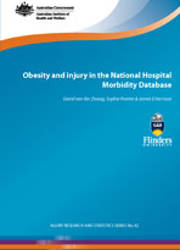Summary
Obesity and injury are major health burdens on society. A recent literature review on possible relationships between obesity and injury revealed some evidence of an association between obesity and injury, but the nature and extent was unclear (Norton et al. 2011). The review made a number of suggestions for further investigation. One suggestion was to examine the feasibility of using the Australian Institute of Health and Welfare (AIHW) National Hospital Morbidity Database (NHMD) to investigate the relationship between obesity and hospitalised injury in Australia, and that is the aim of this report.
Reported obesity in the NHMD
The proportion of Australian hospital separation records for 2008−09 containing an ICD-10-AM obesity code (E66) is much lower than the proportion of people in the Australian population who are obese. About 1% of hospital separation records contain an obesity code.
By comparison, the National Health Survey 2007−08 found that about 25% of Australians aged 18 or older were obese. The low proportion of admitted cases with an obesity code appears to reflect the operation of the Australian Coding Standards (ACS) for admitted patients. If obesity is the main reason for an episode in hospital, then it should be coded as the principal diagnosis. If the presence of obesity is recorded as having affected patient management in certain ways, then it should be coded as an additional diagnosis. Otherwise (with limited exceptions, related to the presence of diabetes), the presence of obesity falls beyond the scope of what should be coded, according to the ACS.
Obesity and hospitalised injury
An examination of the subset of cases with code E66 that also met the definition of injury (ICD-10-AM principal diagnosis in the range S00-T75 or T79) was undertaken. These cases were compared with all other injury separations in the same period. About 1,360 separation records which met the criteria for injury also contained the code E66 Obesity. These comprised only 0.3% of injury separations and 2% of all obesity cases. The injury cases with an obesity code were more likely than injury cases with no reported obesity to involve falls (55% compared with 38%), to have occurred from about age 45 (76% compared with 44%) and to have a longer mean length of stay (13 days compared with 4 days).
Conclusions
The NHMD does not currently provide a reliable basis for measuring obesity among admitted patients, nor to assess the characteristics of injury cases with obesity. Importantly, the data do not identify most records in which the patient is obese. The set of cases that can be identified on the basis of having code E66 is likely to misrepresent patterns of healthcare utilisation for obese patients generally and may not be large enough for certain types of analysis. If measurement of obesity among admitted patients is required, then coding and the availability of data need addressing.
Preliminary material: Acknowledgments; Abbreviations; Symbols
1 Introduction
- Aim
- Defining obesity
- Obesity and injury
2 Identification of obesity in the NHMD
- Obesity coding in Australia
- Other potential indicators of obesity in the NHMD
- Previous approaches to identifying obese patients in admitted patient data
3 Reported obesity in the NHMD
- Data and selection criteria
- Reported obesity hospital separations
- Separations with diagnosis code for obesity
- Procedures for morbid obesity
4 Obesity and hospitalised injury
- Indicators of obesity and injury
- External cause
5 Discussion and conclusions
Appendix A: Data issues
End matter: References; List of tables; List of figures



